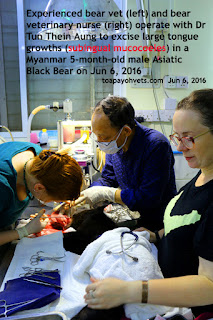Bear parts and bear bile are in great demand in China and Asia.
Commercial poachers with guns enter the jungles of Myanmar.
Encounter a mother bear with 2 toddler cubs. Mother bear rushed towards them.
Gun shots. Mother bear died. Cubs dashed deeper into the forests.
Villagers found them. Brought them to the monastery which provides a sanctuary for them and for 2,500 aged and infirmed people.
4 months passed. The bear cubs grow up fast. But one of them has tongue growths from small sizes to gigantic sizes of tennis balls. Cannot eat solid food. Drinks only milk with bananas.
His tongue swellings continue to expand sideways from below the tongue on both sides. They are soft growths. They look like plastic bags filled with jelly. The bear cannot eat and swallow solid food properly. Malnutrition sets in. Left hind limb becomes swollen.
1. What is the bear suffering from? Ranulas or sublingual mucocoeles. Define. Illustration by intern.
2. Is there a veterinary surgeon in Myanmar able to remove the growths.
The monks at the monastery searches for the vet in Myanmar.
THIS IS A BE KIND TO PETS VETERINARY EDUCATIONAL VIDEO
IN COLLABORATION WITH VETERINARY FILES FROM MYANMAR
SPONSORED BY TOA PAYOH VETS.
IS THERE A BEAR VETERINARY SURGEON IN MYANMAR ABLE TO OPERATE ON THIS ASIATIC BLACK BEAR CUB WITH LARGE RANULAS?
INTRODUCTION
1. SEARCH FOR A BEAR EXPERIENCED VETERINARY SURGEON.
1.1. MYANMAR -
70 MILLION PEOPLE.
TWO ZOOS AT Naypytidaw and in Yangon.
IMAGES
UNIVERSITY OF VET SCIENCE, YEZIN produces around 100 graduates per year.
Is there a veterinary surgeon able to operate on this bear cub?
MIDDLE
1. SEARCH FOR A BEAR VET.
1.1 SURGICAL AND ANAESTHETIC EXPERIENCE COUNTS
SKILLS HONED BY MANY YEARS OF EXPERIENCE IN THOUSANDS OF SURGERIES OF DIFFERENT SYSTEMS
1.2. RELEVANT BEAR EXPERIENCE
1.3. SPECIALIST EXPERIENCE
1.4. OPERATING EQUIPMENT & POST-OP CARE FACILITIES
2. BEAR SURGERY
2.1 GIGANTIC SUBLINGUAL MUCOCOELES OR RANULAS. Define - obstruction of the flow of saliva inside the salivary duct.
Illustration by intern. Normal and swollen tongue of bear. 2 drawings. Coloour.
2.2 SURGICAL TREATMENT
2.2.1 EXCISION OF GLAND
2.2.2 MARSUPIALIZATION. Excise a piece of excessive swollen tongue tissues. The duct is seen. Suture the edges of the duct to the tongue to createa pouch (fistula, pocket) so that the saliva will drain out directly from the salivary gland. The distal put of the excised area is stitched up while the pouch of around 2 cm wide is created nearer to the proximal part of the tongue nearer to the sublingual salivary gland. 3/0 absorbable stitches are used.
NARRATE IMAGES' TEXT
3. BEAR ANAESTHESIA
3.1 Drug combination from Dr Bacon, the bear vet.
Zoletil + Medetomidine combination for sedation IM. In a Zoletil 50 bottle with Zoletil 50 mg powder, add in 2.5 ml of Medetomidine (Domitor). Dosage of combined drug is 1.0-1.5 ml/100kg IM.
3.2 After sedation, intubation. Isoflurane+ oxygen gas given to effect.
3.3 In the first operation on Jun 5, 2016, the bear, weighing 10 kg, was given IM 0.1 ml by the bear vet, Dr Bacon. After 15 minutes, 0.05 ml was given. Ms Caroline Nelson was the veterinary nurses monitoring the anaesthesia. Isoflurane + Oxygen gas maintenance safely sustained the operation.
3.4 In the second operation on June 6, 2016, videoed by Dr Sing Kong Yuen, the bear was less stressed. One injection of 0.15 ml IM was given. The bear was sedated within 60 seconds. Dr Bacon scruffed his neck, got him intubated on the operating table and maintained the ansesthesia with isoflurane + oxygen gas.
CONCLUSION
The interest of the bear comes first. As there is an experienced bear vet and bear vet nurse available, they are the best choice. However, I believe that Dr Thein Tun Aung will make a best second choice as he had more than 16 years of practice in veterinary surgery and anaesthesia in Singapore (10 years) and in his own Royal Asia Veterinary Surgery practice (4 years since start up in 2012)
----------------------------------------------------------------------------------------------------------------

















No comments:
Post a Comment